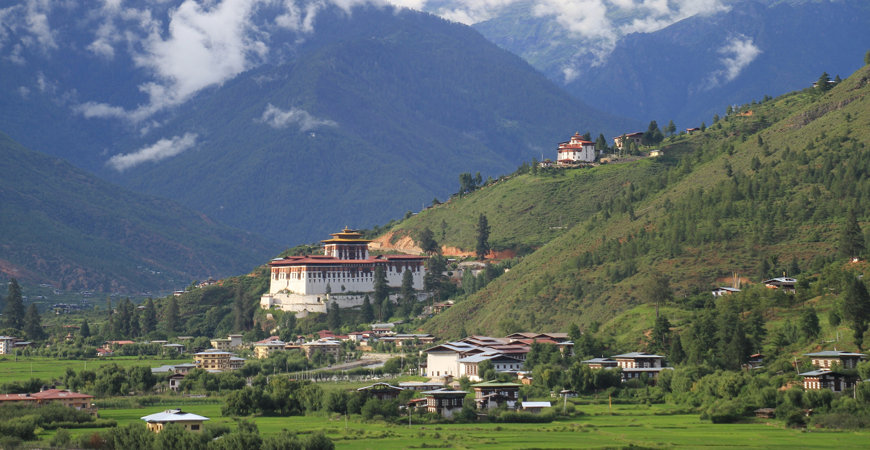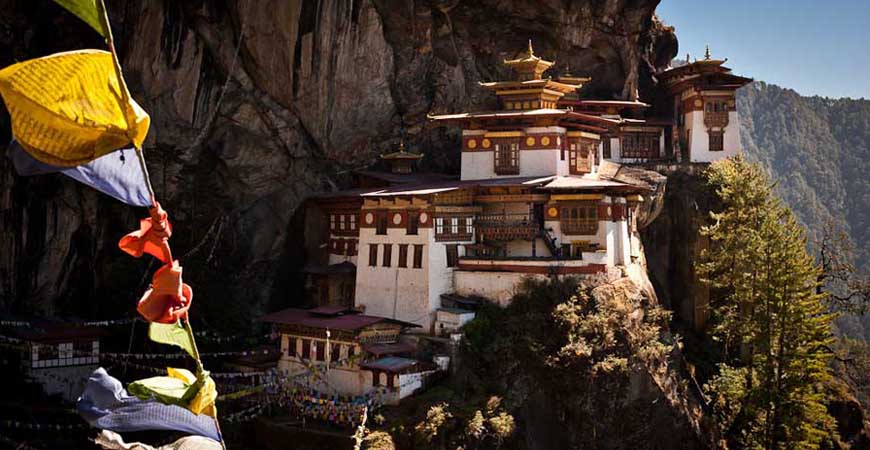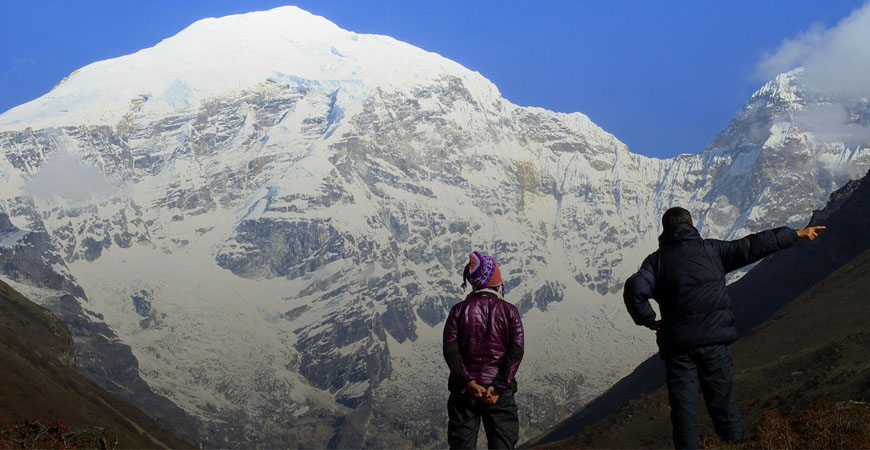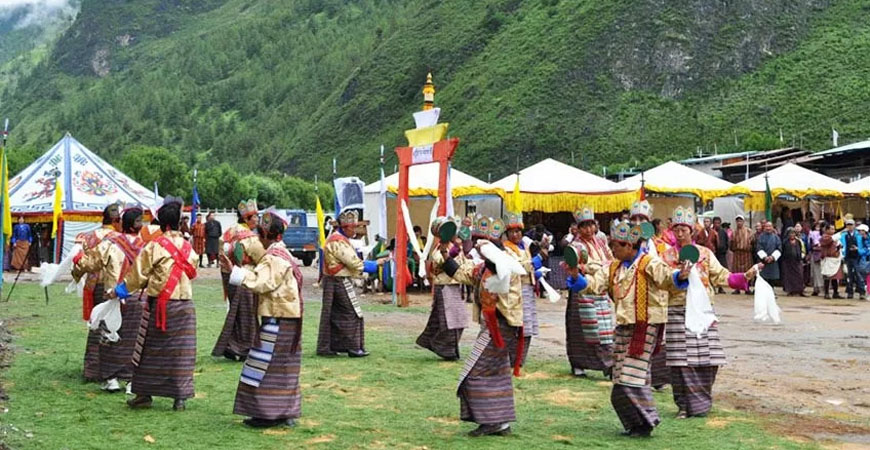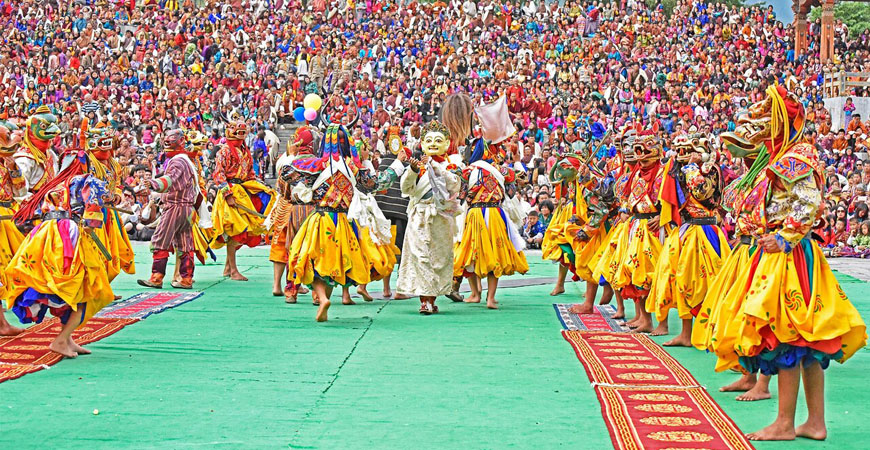03 Nights / 04 Days
| Duration: | 26 Nights / 27 Days |
|---|---|
| Includes: |
|
| Excludes: |
|
Snowman Trek - Detail itinerary
|
Day 1: Arrive Paro International Airport Upon arrival at Paro International airport, you will be welcomed by our company representative and the tour guide will receive and escort you to designated Hotels in Paro. Day 2: Paro to Sharna Zampa The trek starts from Drukgyel Dzong, the ruined fort, which was once defended this valley from Tibetan invasions. The trail then climbs gently through rice terraces and field of millet. Later on we come to apple orchards and forests. Finally at "Gunitsawa", a military camp, which also junctions as a checked point for the army. Here the permits for the trek have to be produced. We continue upwards to just beyond Sharma Zampa, where there are good camping places. Overnight at campsite. Day 3: Sharna Zampa to Soi Thangkha The trail follows the Pa Chu River through a heavily forested area with a few isolated farmhouses. As we go up the valley becomes narrow, wilder and steeper. After crossing a bridge to the left bank of the river, we stop for lunch. Then continue along the river, climbing upwards through Rhododendron forest, and again we have to cross river to reach our campsite. Overnight at campsite. Day 4: Soi Thangkha to Jangothang base camp The path ascends for a while until we reach the army camp. We then follow the river above the tree line, enjoying stunning views of the surrounding peaks. Hot lunch is served at a yak herder's camp. A short walk from here into the valley takes us to our campsite at Jangothang (4,040m). From here, the views of Jhomolhari and Jichu Drake are superb. Overnight at campsite. Day 5: Jangothang acclimatization and exploration Today, you will tackle a four-hour acclimatization hike to the north of your camp. There is practically no trail but you will climb on an open and endless slope till you see the view of Mount Jichu Drakye (6989m). You can scramble further up till 4895m (higher than Mount Blanc) to see amazing view of Mount Jumolhari. You are likely to spot rare blue sheep, Himalayan rhubarb, griffon vultures, golden eagles and the remarkable blue poppy. Jangothang base is a flat grassy land with an old ruined fortress on a hillock in the foreground, beneath the colossal Mount Jumolhari and Jichu Drake. The other viable option is to go on two hours excursion to the twin Tshophu Lakes on the way to Bongtela Pass. Most people show signs of mountain sickness at this altitude and it is recommended that all trekkers halt here. If you do not wish to hike then simply relax in camp, either way it will be a memorable day. Day 6: Jangothang to Lingshi The trail climbs gradually to Nyili La pass. Broad yak pastures can be seen along the length of the route. If the weather is clear, there is an excellent view of Lingshi Dzong as we descending into the Lingshi basin. Tstherimgang and its descending glaciers can be seen at the north end of the valleys. We camp in a stone shelter at 3915 m. Overnight at campsite Day 7: Lingshi to Chebisa Your trail proceed ahead passing Lingshi Dzong built in the 17th century, perched on its hilltop, enjoying exhilarating views of green hills, the winding river, and magnificent peaks. After an hour form Lingshi, the trail reaches a cairn and prayer flags on a ridge and then makes a long descent to the pleasant settlement of Gayul. After leaving this village making a short ascent and descent, the route leads to Chebisa Village. Overnight at campsite. Day 8: Chebisa to Shoumothang Today's trail begins with a stiff climb of nearly four hours up a ridge to Gombu-La (4,500m) and then descends through rhododendrons bushes to a stream at about 4,170m. The trail further climbs over a small ridge through a cedar forest and then to the village of Shakshepasa. Overnight at campsite. Day 9: Shoumothang to Robluthang The trek starts with a climb to Jari-la pass (4,700m) then descending to Tasharijathang valley, the summer grazing ground of the rare Himalayan Takin. Camp is at Tsheri Jathang valley which has been declared a special Takin sanctuary. Day 10: Robluthang to Lingmithang Today's trail start with a long climb up to Shinje-La Pass (4,900m), the last and the highest pass on the trek which is about 5 hours walk from camp. After crossing the pass we descend to Limithang (4,140), a lovely campsite in a big meadow. Day 11: Lingmithang to Laya In the morning we walk to a superb view of Gangchenta peak infront of our camp. The walk to laya is extremely pleasant with wonderful mountain scenery and passing through forests filled with moss and singing birds. We set up a camp on arrival at laya village, the second highest settlement in the country at an altitude of 3,800m. Day 12: Laya Halt Spend the day relaxing visiting Laya Village or going on short hikes above the camp. Day 13: Laya to Rodophu From Laya we descend to the army camp and continue following the river till the turn off point for Rhodophu. After lunch we continue climbing through rhododendron bushes till you reach a hanging valley where there are yaks grazing. Overnight at campsite. Day 14: Rodophu to Narithang After following the river for about half an hour you will have a steady climb to a high open valley at 4,600m and then further up to Tsomo La (4,900m). Tsomo La offers a superb view of Lunana, Mount Jomolhari and Jichu Drake, and the Tibetan border. The route then crosses a flat, barren plateau at about 5,000m. The campsite at Narethang is towered by the peak of Gangla Karchung (6,395m). Day 15: Narithang to Tarina From the camp you will climb for about an hour to Ganglakarchung-La (5,080m). The view from the pass is breathtaking, encompassing the whole mountain range. After crossing the pass, it is a very long descends to Tarina Valley. Overnight at campsite Day 16: Tarina to Woche The path leads down through coniferous forest following the upper ridges of the Pho Chu. The trail then climbs over a ridge and drops to Woche at 3,800m, a settlement of a few houses, the first village in the Gasa region. Overnight at campsite. Day 17: Woche to Lhedi The trek starts with a walk through juniper and fir forests, and further ahead through rhododendron bushes. We climb up to Keche-La Pass (4,480m) where one can have the great views of surrounding mountains. We walk upstream as far as Lhedi Village(3,659m), where we camp overnight. Day 18: Lhedi to Thanza Today the route continues to follow the river, rising gradually to Chozo Village (4,090m) which has a Dzong still in use. After Lunch we will visit the village temple, and then walk for some time to suspension bridge to cross the river. Although there are possibilities to camp at Thanza, most prefer to camp in Thoencha. Day 19: Thanza Halt In Thanza walk around and experience some village life or climb up the ridge for yet other splendid views of lakes and mountains. Day 20: Thanza to Tshochena You will climb to a large boulders hill towards south of Thanza and after few hours of easy walk, we reach Danji (4500m), which is a summer grazing ground for the yaks. At Danji, you may also see herds of blue sheep grazing on the meadows. From Danji, we climb few hundred meters up to the top of the ridge, which offers excellent views of surrounding mountains. Walking for another 20 minutes, will reach at the junction of trails leading to Gangkar Phunsum and Tshochena. We take the trail to the right that leads to Jaze La pass. The Jazela pass, which is at 5200m, offers majestic views of surrounding mountains in all directions. From the pass, the trail descends through snow-capped peaks and lakes to Tshochena 5000m Day 21: Tshochena to Jichu Dramo We follow the shore of a blue-green lake and then climb to a ridge at 5150m, which offers panoramic views of snowy peaks in 360-degree. From here, the road and the microwave tower at Dochu La can also be viewed in far distance. The trail goes up and down over a small, rounded hill. We then pass a glacial lake and reach Loju La pass (5170m), which is a yak pasture with many crisscrossing yak trails. We take a trail that crosses a small saddle-like hill at 5120m to a wide glacial valley. We descend further down to Jichudramo camp (5050m) – this is the highest campsite on our entire trek. Day 22: Jichu Dramo to Chukarpo We will climb through a moraine path to the picturesque Rinchen Zoe pass (5350m), which divides Phochu and Mangdechu basins. The Gangkar Puensum (7520m), the highest mountain in Bhutan can be seen from this pass. Further, the demarcation between the forests and the barren high-altitude areas are remarkably seen from here. Descending through a broad marshy valley with strings of lakes, steep face of moraine and yak pastures, we reach Tampe Chu, which is amidst rhododendron and Juniper forests. We camp at Thongsa Thang (4400m) some distance away from Chukarpo. Day 23: Chukarpo To Tampetsho We descend following the right bank of a river to a Galapang yak pasture at 4025m. We will then climb steeply through forests of junipers and silver firs until we reach Tampetsho. The trail to Tampetsho follows a stream to a beautiful clear, turquoise-colored lake, which is set like in a bowl surrounded by steep ridges. We will camp at end of the lake at 4320m. Day 24: Tampetsho To Maraothang Today, we will climb steeply to the Tampela Pass (4600m). The sight of blue sheep on the mountain slopes above trail is common here. We then descend to the Omtsho Lake. The legend has it that, in 15the century, the famous saint Terton Pema Lingpa miraculously discovered a treasure from this lake. The trail goes toward the shore of the lake and reaches its outlet marked by the prayer flags and then descends steeply pass a waterfall to a small lake. The trail finally meets the left bank of Nika Chu River. After some time, we reach to a large open area close to the confluence a major tributary flowing from east. We will then cross a wooden bridge and walk along mixed forests to reach Maraothang (3620m), which is a wide-open area with yak herder’s camp and your last night camp. Day 25: Maraothang To Nika Chhu Zam The last day of the trek goes gradually downhill through mixed deciduous and bamboo forests. We further descend through forests and pastures connecting to large grassy area overlooking the motor road and Sephu Village (2650m). Your car will be waiting here to transfer you to Wangdue. Overnight hotel in Punakha. Day 26: Punakha - Thimphu Today you will drive to Thimphu, the capital of Bhutan. En route visit Punakha Dzong, which is stunningly situated in between the male and female rivers like an anchored ship. Then drive to Thimphu via Dochula pass. Check into hotel on arrival. After settling in, drive to Kuenselphodrang where the 169ft giant Buddha statue sits. It is supposedly the largest bronze statue in the world. You can spend some time exploring and clicking pictures. Evening is at your leisure. You may explore Thimphu town on your own. Overnight hotel Thimphu. Day 27: Paro International Airport Morning: After an early breakfast, we will drive to Paro Airport for departure. The guests will be seen off by a representative of our company and the tour guide at the exit gate. Wish them bon voyage! |

